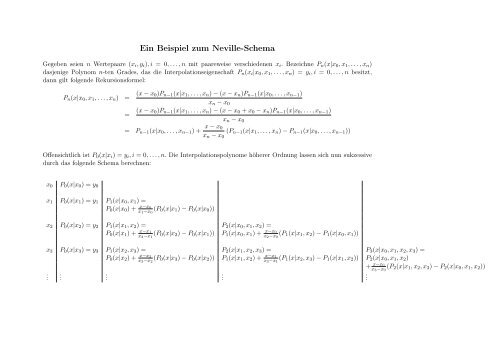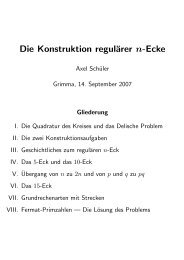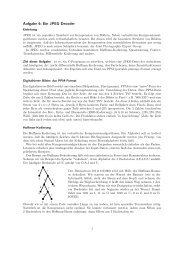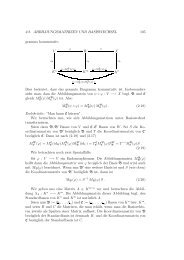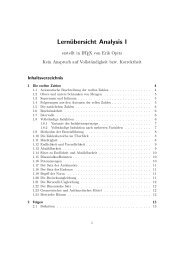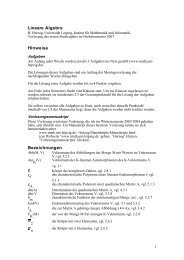Ein Beispiel zum Neville-Schema
Ein Beispiel zum Neville-Schema
Ein Beispiel zum Neville-Schema
Erfolgreiche ePaper selbst erstellen
Machen Sie aus Ihren PDF Publikationen ein blätterbares Flipbook mit unserer einzigartigen Google optimierten e-Paper Software.
<strong>Ein</strong> <strong>Beispiel</strong> <strong>zum</strong> <strong>Neville</strong>-<strong>Schema</strong><br />
Gegeben seien n Wertepaare (x i , y i ), i = 0, . . .,n mit paareweise verschiedenen x i . Bezeichne P n (x|x 0 , x 1 , . . .,x n )<br />
dasjenige Polynom n-ten Grades, das die Interpolationseigenschaft P n (x i |x 0 , x 1 , . . .,x n ) = y i , i = 0, . . .,n besitzt,<br />
dann gilt folgende Rekursionsformel:<br />
P n (x|x 0 , x 1 , . . .,x n ) = (x − x 0)P n−1 (x|x 1 , . . .,x n ) − (x − x n )P n−1 (x|x 0 , . . .,x n−1 )<br />
x n − x 0<br />
= (x − x 0)P n−1 (x|x 1 , . . .,x n ) − (x − x 0 + x 0 − x n )P n−1 (x|x 0 , . . .,x n−1 )<br />
x n − x 0<br />
= P n−1 (x|x 0 , . . .,x n−1 ) + x − x 0<br />
x n − x 0<br />
(P n−1 (x|x 1 , . . .,x n ) − P n−1 (x|x 0 , . . .,x n−1 ))<br />
Offensichtlich ist P 0 (x|x i ) = y i , i = 0, . . .,n. Die Interpolationspolynome höherer Ordnung lassen sich nun sukzessive<br />
durch das folgende <strong>Schema</strong> berechnen:<br />
x 0 P 0 (x|x 0 ) = y 0<br />
x 1 P 0 (x|x 1 ) = y 1 P 1 (x|x 0 , x 1 ) =<br />
P 0 (x|x 0 ) + x−x 0<br />
x 1 −x 0<br />
(P 0 (x|x 1 ) − P 0 (x|x 0 ))<br />
x 2 P 0 (x|x 2 ) = y 2 P 1 (x|x 1 , x 2 ) = P 2 (x|x 0 , x 1 , x 2 ) =<br />
P 0 (x|x 1 ) + x−x 1<br />
x 2 −x 1<br />
(P 0 (x|x 2 ) − P 0 (x|x 1 )) P 1 (x|x 0 , x 1 ) + x−x 0<br />
x 2 −x 0<br />
(P 1 (x|x 1 , x 2 ) − P 1 (x|x 0 , x 1 ))<br />
x 3 P 0 (x|x 3 ) = y 3 P 1 (x|x 2 , x 3 ) = P 2 (x|x 1 , x 2 , x 3 ) = P 3 (x|x 0 , x 1 , x 2 , x 3 ) =<br />
P 0 (x|x 2 ) + x−x 2<br />
x 3 −x 2<br />
(P 0 (x|x 3 ) − P 0 (x|x 2 )) P 1 (x|x 1 , x 2 ) + x−x 1<br />
x 3 −x 1<br />
(P 1 (x|x 2 , x 3 ) − P 1 (x|x 1 , x 2 )) P 2 (x|x 0 , x 1 , x 2 )<br />
+ x−x 0<br />
x 3 −x 0<br />
(P 2 (x|x 1 , x 2 , x 3 ) − P 2 (x|x 0 , x 1 , x 2 ))<br />
.<br />
.<br />
.<br />
.<br />
.
<strong>Beispiel</strong>:<br />
1 1<br />
2 -1 1 + (x − 1)(−1 − 1)<br />
= 1 − 2(x − 1) = 3 − 2x<br />
3 2 −1 + (x − 2)(2 − (−1)) 1 − 2(x − 1) + x−1<br />
2<br />
(5x − 10)<br />
= −1 + 3(x − 2) = 3x − 7 = 1 − 2(x − 1) + 5 2<br />
(x − 1)(x − 2)<br />
4 -2 2 + (x − 3)(−2 − 2) −1 + 3(x − 2) + x−2<br />
2 (21 − 7x) 1 − 2(x − 1) + 5 x−1<br />
x−2<br />
2<br />
(x − 1)(x − 2) +<br />
3<br />
(−2 + 2(x − 1) + 3(x − 2) −<br />
2<br />
(12x − 26))<br />
= 2−4(x − 3) = 14 − 4x = −1 + 3(x − 2)− 7 2 (x − 2)(x − 3) = 1 − 2(x − 1) + 5 2<br />
(x − 1)(x − 2) − (x − 1)(x − 2)12x−36<br />
6<br />
= 1 − 2(x − 1) + 5 2<br />
(x − 1)(x − 2)−2(x − 1)(x − 2)(x − 3)<br />
Welche der verschiedenen, hier benutzen Darstellungen des Polynoms man nimmt ist egal, man wird sich immer die<br />
für den jeweiligen Zweck geeignete heraussuchen. In der allgemeinen Form enthält das <strong>Neville</strong>-<strong>Schema</strong> auch die (fett<br />
gedruckten) Koeffizienten des Newton-Polynoms, also das Newton-<strong>Schema</strong> - hier mal <strong>zum</strong> Vergleich.<br />
x y<br />
1 1<br />
1 2 -1 -2 -2<br />
5<br />
2 1 3 2 3 3 5<br />
2<br />
3 2 1 4 -2 -4 -4 -7 − 7 2<br />
-6 -2<br />
Benötigt man aber lediglich den Wert des Interpolationspolynoms an einer Stelle, dann kann man gleich mit diesem<br />
x rechnen.<br />
<strong>Beispiel</strong>: x = 1 2<br />
1 1<br />
2 -1 1 + ( 1 2<br />
− 1)(−1 − 1) = 2<br />
3 2 −1 + ( 1 2 − 2)(2 − (−1)) = −11 2 = −5, 5 2 + 1 2 −1<br />
2 (−11 2 − 2) = 31 8<br />
= 3, 875<br />
4 -2 2 + ( 1 2 − 3)(−2 − 2) = 12 −11 2 + 1 2 −2<br />
2 (12 + 11 2 ) = −149 8 = −18, 625 31<br />
8 + 1 2 −1<br />
3 (−149 8 − 31 8 ) = 183<br />
24<br />
= 7, 625


